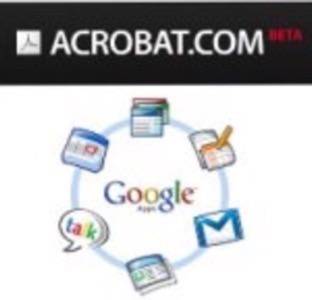Today, Adobe announced that their online office suite at Acrobat.com is moving out of beta and they will begin offering both free and paid subscriptions to the web-based suite of applications. For consumers, the change won’t have that much of an impact since the core services at Acrobat.com will remain free: Buzzword (the word processor), Presentations (slideshows, still in beta), and Tables (spreadsheets, new today). However, business users will now face a dilemma as Adobe begins to charge for PDF conversion as well as their web meetings product, Adobe ConnectNow.

This move clearly pits Adobe against Google, with both companies now offering premium services to business users. But what will companies choose? Google or Adobe? What would you choose?
Adobe’s New Acrobat.com
Along with the announcement about the preview release of Tables, an online spreadsheet application which joins Presentations in the Adobe Labs area, the bigger news today is the pricing plans for the online live meeting service, ConnectNow. Adobe will offer two different plans, a Premium Basic Service and a Premium Plus Service. In addition to online meetings, each service will also include support options and allow users to convert files to PDF format, another feature that will not be accessible to those using the free version of Acrobat.com.

The Basic Service allows up to five participants in an online meeting and supports the conversion of ten documents to PDF per month. This service will cost US $14.99/month, or US $149/year.
The Premium Service allows for up to twenty participants and supports unlimited PDF creation. It will be US $39/month, or US $390/year.
Google Apps: The Better Web Office?
Compared with Google Apps, Adobe’s online suite, while arguably a sleeker-looking product, is still very raw when it comes to features. Two of the core office services (Presentations and Tables) are still in beta and there are no email, calendaring, or portal-type applications as there are with Google. In other words, Adobe is content to supplement or replace a business’s Microsoft Office install base, whereas Google wants to replace that plus your Exchange server and Sharepoint Server, too.
At $50 per user per year, the question as to whether Google Apps is the more expensive buy really depends on the number of users the company has.
Still, Adobe’s key to success is that they’re offering something Google doesn’t: live web meetings. The closest Google can come to that is Google Video, which allows users to share pre-recorded video presentations like company announcements or training videos. Another option would be Gmail Chat, but it doesn’t include ConnectNow’s whiteboarding feature. Google also has nothing to do with PDF conversion, although they do allow users to upload and share PDFs in the Google Docs portal.
What To Choose?
Still, when it comes down to it, it’s doubtful that any business would pay for two web office suites at the same time just to get a complete set of features. Not only would that not make financial sense, from a support perspective, it would be a mistake, too, especially considering that standardization and consistency are important factors to today’s I.T. departments.
Instead, most companies moving to the cloud will have to make the choice: Google or Adobe? What will they choose? What would you choose if you had to decide?
Take the poll and let us know. Feel free to share your reasons why in the comments.
UPDATE: As a few commenters noted, Zoho is also a valid choice for web office suites. However, we intentionally left them out so as not to dilute the vote between the two companies that are arguably industry giants as opposed to (awesome!) startups. ThinkFree is also not included for that reason. If you would choose Zoho, though, vote “Neither” and leave a comment as to why.










